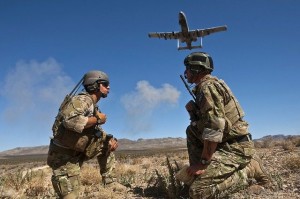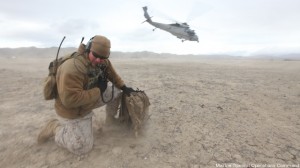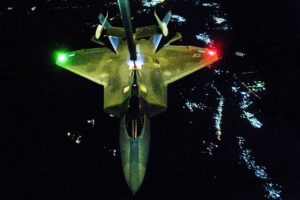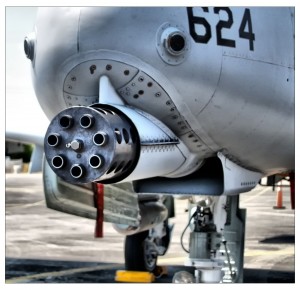Gen. Carlisle: JTACS In Iraq Would Mean Lots Of US Ground Troops
Posted on
America was surprised last summer by the Islamic State of Iraq and the Levant’s (ISIL) lightning offensive. After 25 years of flying and fighting around the world. the Air Force’s Air Combat Command was able to rapidly shift portions of its Intelligence, Surveillance and Reconnaissance (ISR) network towards Iraq, launching 80 ISR missions over Iraq in the first month of the Islamic State offensive. U.S. air strikes on ISIL forces have struck more than 7,600 Islamic State targets and killed an estimated 10,000 enemy fighters.
Breaking Defense contributor James Kitfield sat down with ACC commander General Herbert “Hawk” Carlisle in his headquarters at Langley Air Force Base to discuss how the Air Force has maintained its ability to rapidly respond to global crises during a time of force contraction and tight budgets. Edited excerpts from that interview follow.
JK: Do the lessons from over a decade of conflict explain ACC’s rapid response to the crisis in Iraq and Syria last year?

An A-10 “Warthog” flies low overJoint Tactical Air Controllers in a Nevada exercise.
HC: First I would tell you that the speed, range and flexibility of airpower that we brought to that fight is remarkable, and first and foremost a tribute to our airmen. But I would argue that the Air Force deployed for war 25 years ago for Operation Desert Storm, and we never came home from war. We’ve flown nearly non-stop in the Northern and Southern no-fly operations over Iraq, in the 1999 Serbian air campaign, in Operation Enduring and Iraqi Freedom, and in other operations. So we’ve been flying in combat-like conditions for the past quarter century. During that time we’ve made major strides in precision strike that can put a weapon through a window and better control collateral damage, and in an ISR enterprise that can rapidly put an “unblinking eye” over any place on earth and provide joint warfighters with accurate situational awareness in real time. Those are truly revolutionary capabilities, and they’ve changed how people think about airpower.
JK: But hasn’t Operation Inherent Resolve also shown that you still need ground forces to defeat a determined enemy?
HC: In terms of operations against ISIS, I would argue that U.S. airpower did extraordinarily well in stopping the advance of its forces last year in Iraq. U.S. airpower was critical in helping the Kurds successfully defend Kobane [in Syria], by putting Close Air Support over their heads for months. In that fight we were able to put a bomb on the forehead of an ISIS fighter in a nanosecond, and that paid off. U.S. airpower was also instrumental in helping Iraqi forces recapture Tikrit. In the case of Ramadi and Anbar Province, that’s still a tough fight, but even U.S. Marines and Army forces had a tough time in Anbar. Part of the problem is the sheer complexity of the battlefield. A pilot flying overhead has to differentiate between moderate and extremist Sunni forces; between moderate Shiite militias and Iranian-backed Shiite militias; between moderate and extremist Sunnis in Syria, and Shiite government forces backed by Iran; and between Kurds and Arabs in the north. So part of the problem is this very complex battlefield, and we’re not even sure what the end game looks like.
JK: Wouldn’t JTACS (Joint Terminal Attack Controllers) on the ground give you a more granular and accurate targeting capability?
 HC: Yes it would, but to achieve that you would have to put in a big enough U.S. ground force to protect those JTACS, and to evacuate them if need be. My concern is that if we put that kind of force on the ground we will own Iraq.
HC: Yes it would, but to achieve that you would have to put in a big enough U.S. ground force to protect those JTACS, and to evacuate them if need be. My concern is that if we put that kind of force on the ground we will own Iraq.
Do the American people want to own Iraq again? Do we want to own Syria, which because of its long civil war is now a failed state? Will Syria or Iraq even be single [unitary] states when this is over? I don’t know the answers, but I think [U.S. Central Command Commander] General Lloyd Austin has done an extraordinary job in stopping ISIS’s advance in Iraq and putting enough pressure on the group to give the Iraqi government time to take shape and develop. In the meantime, U.S. airpower will continue to wreck havoc on ISIS forces.
JK: You talk of being at war for 25 years, but at the time of Desert Storm in 1991 the Air Force had 188 fighter squadrons and 511,000 active duty airmen. You’re now down to just 49 squadrons and roughly 311,000 active duty airmen. Are you worried that under the current “sequester” budget limits you may have to shrink further?
HC: I have huge concerns. I don’t want to be melodramatic, but if we do not change sequestration and start financing the U.S. military adequately again, by the turn of this decade we will have to change the Air Force completely. We will cease to be a global air force. We will still be the best air force in the world, but we will have to shrink our capacity to the point that we will only be able to cover one region at a time. Remember on top of fighting ISIS in Iraq and Syria and the Taliban in Afghanistan, we are presently conducting deterrence operations in the Pacific and on the Korean Peninsula, we are dealing with Russian actions in Ukraine, and tracking threats and crises in Libya, North Africa, Somalia, and the Horn of Africa in Yemen. Our capacity is stretched to its limits, and if sequestration continues we will no longer be that kind of global Air Force.
JK: Where are you seeing stress fractures start to develop?
HC: My biggest concern is that, as we try and maintain readiness and this high operations tempo, we have cut modernization to the breaking point. If we don’t find a way to fix that our potential adversaries will outstrip us in terms of capability, and we can’t let that happen. If you look at what Russia and China are doing in terms of military modernization, you can tell they are driven by the goal of denying the United States air superiority. I was in China a year-and-a-half ago, and the head of the Chinese air force said, “We watched you in Desert Storm, we watched you in Operation Allied Force in Serbia, and we watched you in Operations Enduring and Iraqi Freedom. We knew we had to change or else we couldn’t keep up with you!” So if you look at our potential adversaries like China, Russia, North Korea, and Iran, they are all determined to deny us this air superiority we’ve enjoyed for the past 25 years, where in every operation we essentially owned everything more than 8 feet off the ground. If they don’t deny us air superiority, our adversaries know they don’t have a chance in a fight against us. To maintain that air superiority we have to increase our modernization.
JK: The average age of Air Force aircraft is now 27 years old, and Congress recently denied the Air Force’s request to retire the A-10 aircraft. How has that affected your plans to field the new F-35 fighter, your primary modernization project?
HC: It’s created a big challenge, because when I look at the 2016 and 2017 budgets, Congress is unfortunately not letting us cut what we can no longer afford. I’m trying to field the first units of the F-35 stealth aircraft at Hill Air Force Base, for instance, and the maintenance manpower I intended to use to support them was supposed to transition from the A-10 units. We also have Block 40 F-16s at Hill that I would like to use to convert the two A-10 wings to F-16 wings. I’m not allowed to do that either.
JK: Some in Congress argue that the Air Force still needs the A-10 for close support of ground forces.
HC: Listen, I love the A-10. I think it’s a fantastic aircraft with a phenomenal combat record. But if someone tells me I can only afford to keep two out of three aircraft – the A-10, the F-16 and the F-35 – I have to pick the F-16 and F-35, because they can fly more kinds of missions. No airframe conducts close air support of ground forces as good as the A-10, but that’s essentially the only mission it can do, and it doesn’t do it as well in a contested or high threat environment as the F-16 or F-35.
JK: How concerned are you about Air Force psychological studies that have reportedly found unsustainable levels of stress among the airmen who operate remotely piloted aircraft (RPA) and analyze ISR data on bases in the United States?
HC: Those airmen involved in our RPA and ISR enterprises are incredibly stressed. This is a new way of war, and I don’t think we truly understand yet the impact it is having on our airmen and their families. Because of the incredible demand for what they do, these people work 6 days a week on 12-hour shifts, and they rarely get to go on leave or to school because we can’t spare them. They generally love their job, because they have an incredible impact in terms of saving the lives of our warfighters down range, and taking it to the enemy. But they need a break.
JK: What steps are you taking to relieve those stresses?
HC: We have launched a Culture and Process Improvement Program that is studying ways we can improve the quality of life for these young men and women. We want to cut their work hours to more sustainable levels. A lot of them work the night shift six days a week, for instance, and then on their one day off they have to try and adjust to a daytime schedule in order to spend time with their family. That alone is very stressful. One idea is to spread them around the world in different time zones so that they are always working in day time. We also have a team at Creech Air Force Base where many of our RPA pilots and crews are based. It includes a flight surgeon and a psychologist that are studying the human factor in these types of operation. We’ve done the same at the 480th ISR Wing here at Langley.
JK: What feedback are you hearing from them?
HC: You know, it’s hard to watch what some of these airmen watch on a given shift — and when called upon to commit the necessary destruction — and then just to walk out the door and drive off base and have the wife call on the way home to tell you to pick up a quart of milk at the local Walmart. That almost instant transition from combat to a normal routine is tough. I don’t think we as a nation understand how that impacts people.
Subscribe to our newsletter
Promotions, new products and sales. Directly to your inbox.


